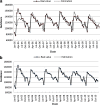A hybrid seasonal prediction model for tuberculosis incidence in China
- PMID: 23638635
- PMCID: PMC3653787
- DOI: 10.1186/1472-6947-13-56
A hybrid seasonal prediction model for tuberculosis incidence in China
Abstract
Background: Tuberculosis (TB) is a serious public health issue in developing countries. Early prediction of TB epidemic is very important for its control and intervention. We aimed to develop an appropriate model for predicting TB epidemics and analyze its seasonality in China.
Methods: Data of monthly TB incidence cases from January 2005 to December 2011 were obtained from the Ministry of Health, China. A seasonal autoregressive integrated moving average (SARIMA) model and a hybrid model which combined the SARIMA model and a generalized regression neural network model were used to fit the data from 2005 to 2010. Simulation performance parameters of mean square error (MSE), mean absolute error (MAE) and mean absolute percentage error (MAPE) were used to compare the goodness-of-fit between these two models. Data from 2011 TB incidence data was used to validate the chosen model.
Results: Although both two models could reasonably forecast the incidence of TB, the hybrid model demonstrated better goodness-of-fit than the SARIMA model. For the hybrid model, the MSE, MAE and MAPE were 38969150, 3406.593 and 0.030, respectively. For the SARIMA model, the corresponding figures were 161835310, 8781.971 and 0.076, respectively. The seasonal trend of TB incidence is predicted to have lower monthly incidence in January and February and higher incidence from March to June.
Conclusions: The hybrid model showed better TB incidence forecasting than the SARIMA model. There is an obvious seasonal trend of TB incidence in China that differed from other countries.
Figures



References
-
- WHO. Global tuberculosis control 2010. Geneva: World Health Organization; 2010.
-
- Tanaka M. Tendency of seasonal disease in Japan. Global Environ Res-English Edition. 1998;2:169–76.
Publication types
MeSH terms
LinkOut - more resources
Full Text Sources
Other Literature Sources
Medical

